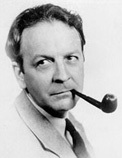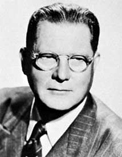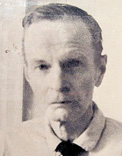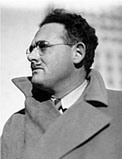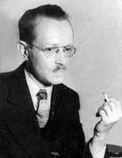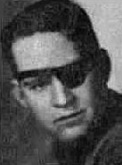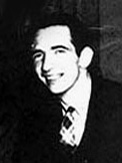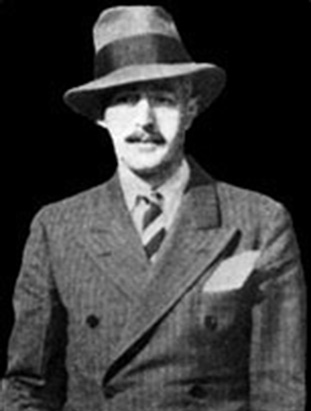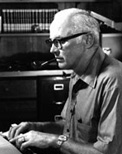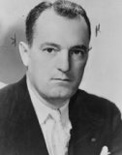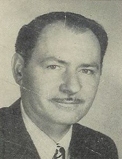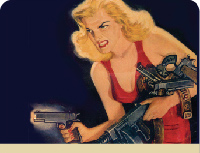|
RAYMOND (THORNTON) CHANDLER (1888 -1959) was born in
Chicago, then taken to England as a child and became a British citizen in 1907,
but returned to America in 1912 and eventually regained his American citizenship
in 1956. He worked in numerous jobs before selling his first short story to
Black Mask in 1933 at the age of forty-five. Although he is regarded today as perhaps
the greatest private-eye writer who ever lived, his pulp stories brought him
little fame and not much financial benefit. The detectives in those stories bore
different names (Cannady, Dalmas, Mallory, Malvern, and an unnamed protagonist),
but they were essentially interchangeable with his most famous hero,
Philip Marlowe. After he achieved success with the publication of his first novel,
The Big Sleep (1939), the stories were collected in several volumes
and the protagonists' names were all changed to Marlowe. Chandler produced
only seven novels in his career, six of which were filmed. ERLE STANLEY GARDNER (1889 -1970) was born in Malden, Massachusetts, and studied law on his own; he never got a degree, but passed the bar exam in 1911, practicing law for about a decade. He made little money, so he started to write fiction, selling his first mystery to a pulp magazine in 1923. The rest, as many have said, is history. For the next decade, he published approximately 1.2 million words a year, the equivalent of a full-length novel every three weeks. It was not until 1933, however, that he wrote his first novel, The Case of the Velvet Claws, which introduced his incorruptible lawyer, Perry Mason, who went on to become the bestselling mystery character in American literature, with 300 million copies sold of eighty-two novels. CORNELL (GEORGE HOPLEY) WOOLRICH (1903-1968) was born in New York City, grew up in South America and New York, and was educated at Columbia University, to which he left his literary estate. A sad and lonely man who desperately dedicated his books to his typewriter and to his hotel room, Woolrich was almost certainly a closeted homosexual and an alcoholic. Perhaps not surprisingly, then, the majority of his work has an overwhelming darkness, and few of his characters, whether good or evil, have much hope for happiness—or even justice. No twentieth-century author equaled Woolrich’s ability to create suspense, and Hollywood producers recognized it early on. Few writers have had as many films based on their work as Woolrich, perhaps the most well-known being Rear Window (1954), based on "It Had to Be Murder."
LESTER DENT (1904 -1959) was born in La Plata, Missouri, but grew up
on a ranch in Wyoming. While working as a Western Union telegraph operator,
he learned that a coworker had sold a story to a pulp magazine for the
princely sum of $450. As a reader of the pulps, he decided to try it
himself. Soon after, he moved to New York for a full-time writing job with
Dell Publishing, then had the chance to launch a new series for Street &
Smith. After staggering success with
The Shadow, S&S hoped to duplicate it with a detective who used
various gadgets to fight crime, and Dent created Doc Savage under the house
name Kenneth Robeson. After Doc Savage, the character for which Dent
received the most acclaim was Oscar Sail, the loner boatman who appeared in
only two Black Mask stories, "Sail" and "Angelfish." The story in this
collection, "Luck," is an early draft of that first adventure about Oscar
Sail and a more preferred by the author than the final editor-influenced
version. FREDRIC BROWN (1906-1972) was born in Cincinnati, Ohio, and attended the University of Cincinnati and Hanover College before becoming an office worker from 1924 to 1936. He then took a job as a proofreader and reporter for the Milwaukee Journal. A chronic respiratory problem caused him to move to Taos, New Mexico, then Tucson, Arizona. While at the Journal, he sold his first short story and went on to publish more than three hundred stories in his lifetime, as well as nearly thirty novels, in both the science fiction and mystery genres. Equally revered by fans of science and mystery fiction, the Edgar Allan Poe Award-winning Brown was one of the most original, creative pulp writers of his time, his stories often having astonishing twists and surprise endings, frequently leavened with humor. Brown wrote scripts for Alfred Hitchcock Presents, and several television dramas and films were made from his books. BRETT HALLIDAY was one of the pseudonyms of the prolific Davis Dresser (1904-1977). Born in Chicago, he spent his childhood in Texas, where he ran away from home at the age of fourteen to join the army until his true age was discovered when he was sixteen. He returned to school and received a civil engineering certificate but, when work was hard to come by during the Great Depression, began to write, turning out scores of mystery, Western, romance, adventure and sex stories for the pulps. He also wrote as Asa Baker, Matthew Blood, Peter Shelley, Anthony Scott, Hal Debrett, and many other pseudonyms. It was with the character Michael Shayne, however, that Dresser found success. Based on a character he had met while working in Mexico on an oil tanker, the big redheaded private eye was one of the most popular detectives of the ’40s, ’50s, and ’60s, with more than sixty novels, numerous short stories and novelettes, a magazine named for him, a radio series, a television series, and a dozen movies in the 1940s.
NORBERT DAVIS (1909 -1949) was born in Morrison, Illinois, and moved
with his family when he was a teenager to California, where he earned a law
degree at Stanford University. By the time he had graduated, however, he had
already established himself as a successful pulp writer and, having always
desired the writer’s life, never bothered to take the bar exam. While he is
most remembered today for his detective fiction (and rightly so), he also
wrote other pulp fiction, including Westerns, romances, and adventure
stories, as well as humor for the top slick magazines. He joined a group
called the Fictioneers, Southern Californian fiction writers who met
regularly to discuss writing and marketing tips; Raymond Chandler was an
occasional participant. Davis’s best-known characters are the private-eye
team of Doan and Carstairs—the latter being a giant Great Dane. The Doan
and Carstairs stories are notable for being among the funniest of the
"hardboiled" genre of their time. DASHIELL HAMMETT (1894-1961) is arguably the most significant author of the hard-boiled private-eye novel in the history of American letters. Carroll John Daly is credited with inventing the genre, but it is Hammett who popularized it while elevating it to the level of serious literature. By far his best-known work, and the most famous mystery novel ever written by an American, is The Maltese Falcon. After Hammett had written numerous short stories, novellas, and two novels about the Continental Op, the series character that had made him both famous and successful, The Maltese Falcon was a major departure, the protagonist being the newly created but now iconic Sam Spade. Whereas the Op worked for a large firm and had a boss to whom he was answerable, Spade worked only with a partner who was murdered early in the novel, after which he was responsible to no one but himself and his sense of ethics. Like most of Hammett’s important work, The Maltese Falcon was originally published in Black Mask. It was a five-part serial running from September 1929 to January 1930. The story in book form is substantially different from the serial edition on this audio collection. JOHN D (ANN) MACDONALD (1916 -1986) was born in Sharon, Pennsylvania, moved to Utica, New York, received a B.S. from Syracuse University, then an M.B.A. from Harvard. He worked as a
businessman without much success, then joined the army, serving from 1940 to
1946, achieving the rank of lieutenant colonel in the OSS. When he returned
to the United States, he began to write full-time, selling sports,
adventure, fantasy, science fiction, and mystery stories to pulp magazines
and such slicks as Liberty, Cosmopolitan, and Collier’s. His 1949 move to
Florida gave him access to the water and boating, which served as the
background for many of his novels, notably those about Travis McGee.
One of the great characters of mystery fiction, McGee is a combination
private detective and thief who makes his living by recovering stolen
property and, while living outside the law, victimizes only criminals.
MacDonald’s suspense novel The Executioners (1958) was filmed
twice as Cape Fear. HORACE MCCOY (1897 -1955) was born in Pegram, Tennessee, and went to school in Nashville, dropping out at sixteen to get a job. After serving in the U.S. Army Air Corps during World War I, he became the sports editor of the Dallas Journal, a job he held from 1919 to 1930. He moved to Hollywood in 1931 to become an actor and to write motion picture screenplays. McCoy had been selling stories, mostly mysteries, to various pulps, the majority to Black Mask, between 1928 and 1932, after which he devoted himself full-time to film scripts and novels, most of which were filmed. His first book, a noir Depression-era existential novel, They Shoot Horses, Don't They? (1935), was inspired by his job as a bouncer at the Santa Monica Pier; it was filmed by Sydney Pollack, with Gig Young, Jane Fonda, and Michael Sarrazin fourteen years after McCoy died of a heart attack. FRANK GRUBER (1904-1969) was born in Elmer, Minnesota, and worked as a bellhop, ticket taker at a movie theater, writer and editor of trade journals, and creative writing teacher at a correspondence school before he became a fulltime writer. He was still in his twenties when he sold his first story, beginning a career that produced more than four hundred stories, sixty novels, and more than two hundred film and television scripts, mainly in the mystery and Western fiction genres. He also wrote more than a dozen novels featuring the amateur detective Johnny Fletcher and his partner, Sam Cragg, a pair of always broke con men who made their debut in The French Key (1940), which Gruber wrote in seven days yet which made most of the year’s top-ten lists. These are just a few of the fascinating, prolific, and influential authors whose works are part of the Black Mask Audio Series. |
